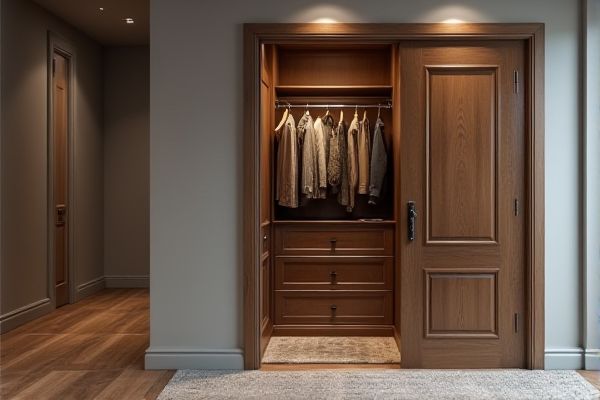
Wall safes offer discreet security by being hidden within walls, while closet safes provide easy access and often larger storage capacity for valuables. Understanding the benefits and limitations of each can help you choose the best option for protecting your belongings--read on to explore which safe suits your needs.
Table of Comparison
| Feature | Wall Safe | Closet Safe |
|---|---|---|
| Installation | Built into wall, requires professional installation | Free-standing, no installation needed |
| Security Level | High; concealed and flush with wall | Moderate; visible but hidden inside closet |
| Space Utilization | Saves floor space, uses wall cavity | Occupies floor space in closet |
| Accessibility | Less accessible; requires wall access | More accessible inside closet |
| Size Options | Typically smaller; fits between studs | Varies widely; larger sizes available |
| Cost | Higher initial cost due to installation | Lower cost, no installation fees |
| Best Use | Concealed valuables; firearms, documents | General storage; larger items or multiple valuables |
Introduction to Wall Safes and Closet Safes
Wall safes are discreet security compartments embedded into walls, offering concealed protection for valuables without occupying floor space. Closet safes, on the other hand, are freestanding units designed for secure storage within closet interiors, providing easier access but less concealment. Your choice depends on balancing accessibility with the level of stealth and integration within your living space.
Security Features Comparison
Wall safes offer enhanced security through concealed installation within walls, making them less accessible to burglars compared to closet safes, which are typically freestanding and more visible. Wall safes often come with reinforced steel construction, tamper-proof locking mechanisms such as biometric or digital keypads, and anchor points for secure mounting, increasing resistance to forced entry. Closet safes provide moderate protection but generally lack the discreet placement and robust anchoring options found in wall safes, making them more vulnerable to theft attempts.
Installation Process: Wall Safe vs. Closet Safe
Wall safes require professional installation within a wall cavity, ensuring they are securely anchored between studs for maximum protection against theft. Closet safes offer more flexibility in placement, often requiring only simple floor anchoring without structural modifications, making installation quicker and less invasive. Your choice depends on whether you prioritize discreet, built-in security or easier, portable placement options.
Space Utilization and Accessibility
Wall safes optimize space by being recessed into walls, making them ideal for discreet storage without sacrificing room in your closet or floor area. Closet safes offer more accessible and flexible storage options, allowing you to easily retrieve items without the need to open walls. Choosing between the two depends on your priorities for convenience versus maximizing hidden storage space.
Concealment and Discretion
Wall safes offer superior concealment by being hidden within the structure of a wall, making them less visible and easier to disguise behind pictures or panels. Closet safes, while providing easy access, are more prone to detection due to their external placement, often requiring additional measures like false walls or furniture covers for effective discretion. Your choice should prioritize the level of stealth you need, with wall safes generally excelling in maintaining secrecy and minimizing discovery risk.
Durability and Construction Material
Wall safes are typically constructed with heavy-gauge steel and reinforced hinges, offering superior durability against forced entry compared to closet safes, which often use lighter materials for easier concealment. The solid steel construction of a wall safe enhances resistance to prying and drilling, providing stronger protection for your valuables. Your choice between a wall or closet safe should consider the level of security needed, with wall safes generally delivering more robust defense due to their sturdier build.
Fire and Water Resistance
Wall safes typically offer superior fire and water resistance compared to closet safes due to their construction with thicker steel and specialized seals designed to protect valuable contents. Closet safes, while convenient, often lack the enhanced protective features found in wall safes and may be more vulnerable to fire and water damage. For your valuables, choosing a safe with verified fire and water resistance ratings ensures better protection in emergencies.
Cost Comparison: Wall Safe vs. Closet Safe
Wall safes generally cost more than closet safes due to reinforced steel construction and installation requirements within walls. Closet safes are often more affordable and easier to install, offering flexible placement without structural modifications. Your choice depends on budget constraints and desired security level, with wall safes providing higher protection at a higher price point.
Best Use Cases for Each Safe Type
Wall safes are ideal for securing valuables in hidden spaces within walls, making them perfect for apartments or rooms with limited floor space, offering discreet protection against theft. Closet safes provide larger storage capacity and easier accessibility, suitable for home offices or bedrooms where users need frequent access to documents, firearms, or cash. Choosing the right safe depends on balancing concealment needs versus storage size and ease of access.
Choosing the Right Safe for Your Needs
Selecting between a wall safe and a closet safe depends on security level, space availability, and accessibility preferences. Wall safes offer higher concealment by being embedded into walls, ideal for protecting valuables from theft and fire without occupying floor space. Closet safes provide larger storage capacity and easier installation, suited for storing bulkier items where quick access is necessary.
 homyna.com
homyna.com